Enclosure Placement in Room Affects Overall Performance
In the previous section we discussed the degree of the reflection of sound by the walls of the room in connection with the reverberation characteristics of the room. It was pointed out that the quality of these reflections made the room a very integral part of the acoustic circuit.
However, there is one other important manner in which the room affects the acoustical performance of the system, and that is in actually changing the "baffle" characteristics of the enclosure by the placement of the enclosure in certain specific locations of the room. It is with this aspect of the problem that we are presently concerned.
Closely Located Image of Speaker "Enlarges" Speaker Size
It was seen that in a live room the reflected ray of sound energy coming to the listener's ear gave rise to a virtual new source of sound apparently on the other side of the wall. For all practical purposes, the wall created a new source of sound, which, in the discussion of reverberation properties, was credited with lending increased acoustic perspective to the system. However, there is more to the question of reflected sources of sound than their accumulated "perspective" qualities. It is actually possible to increase the low-frequency efficiency of a loudspeaker-enclosure combination by judiciously choosing the proper place in the room for the system. If the sound source produces an image of itself close to the original source of sound, the reflected image, which is a real source of sound that works back upon the primary source (the loudspeaker), changes the loading characteristics upon the speaker, effectively increasing the "size" of the speaker by an amount proportional to the size of the "image." The acoustic coupling that exists between the primary source (the loudspeaker) and the image is such as to increase the radiation resistance for the original vibrating system, because of the apparent increase in size of the source.
The more sources of reflection there are close to the original source, the better the radiation characteristic.
Mid-wall Placement: No Image
For purposes of developing this thought, let us place a loudspeaker in the center of a wall and well above the floor. In this case, the fact that the speaker is removed far from all reflecting walls means that any images formed on the walls are comparatively weak and far from the speaker, and are relatively ineffective in changing the original performance of the speaker. Thus, in this mid-wall position, the operation of the speaker is completely a function of the capabilities of the speaker itself in its wall baffle.
Baseboard Center Wall Placement: One Image, Plus "Two-Sided Horn"
Now let us move the loudspeaker down to the bottom of the wall so it is near the floor, as shown in Fig. 16-1 (A). Because low frequencies diffract so readily, the low frequencies from the loud speaker in the present position will immediately bounce over to the adjacent floor plane, which lies in such close proximity to the speaker.
Because the floor is so close, the low frequency beam from the loud speaker will create a sharp image of itself in the floor and bounce away from the floor. In effect, we now have two sound sources close to one another, one original and one reflected. The fact that the floor area where the image is formed does not vibrate while the image is radiating does not in any way detract from its action as a piston source roughly equivalent to that of the original source. Accordingly, we ought to be able to apply the same radiation resistance relationships for this created image as for the original source -- the radiation resistance the piston sees is proportional to the frequency times the diameter of the piston. It would seem then that we now have two piston sources of a total area almost twice the original area of the speaker. Consequently, we should expect considerably better low frequency response for this system because it has effectively a product of frequency and area that is twice as large as the original. Although the mutual radiation coupling is not quite as large as this approximation shows, there is sufficiently greater radiation resistance in this position to warrant placing the speaker close to the floor.
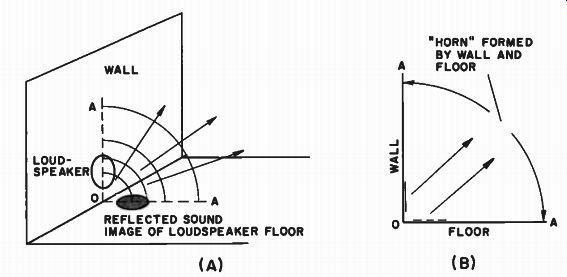
Fig. 16-1. The speaker close to the floor creates an acoustic image of
itself. These two sound sources, close together, form a larger single
source located at the apex of a "horn" formed by the wall and
the floor.
This artificially increased piston size is, however, not the only action that comes into play when the speaker is located in this position. If we were to take a cross-section down through the wall and the floor as shown in part (B) of Fig. 16-1, we would readily recognize that the corner formed by the wall and the floor presents a form of horn that feeds the room. The horn thus formed is driven by the original source of sound and the secondary source close to it at the apex of the horn. Although this is not a true horn, it certainly represents a good approach to a horn, much better in fact than the simple speaker placement in the center of the wall. It is fortunate, of course, that almost all of today's loudspeaker enclosures are placed on the floor, and this baseboard "horn" coupling does exist. Those few individuals who use the wall infinite baffle necessarily deprive themselves of the benefits of such auxiliary floor-to-wall loading.
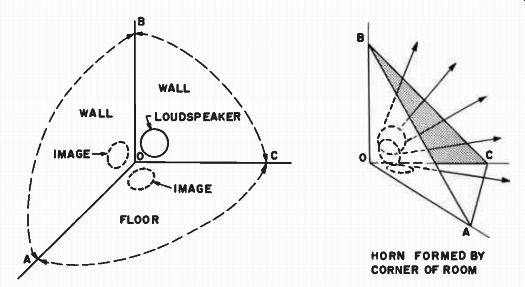
Fig. 16-2. When the speaker is placed down in the corner, two acoustic
images are formed on the wall and floor. These multiple sound sources,
located in the corner, act as a single larger radiator at the apex of
a three-sided horn.
Corner Placement: Two Images Plus "Three-Sided Horn"
We may now extend this concept to the adjacent wall of the room by placing the loudspeaker in the actual corner of the room (but still on one of the walls) as shown in Fig. 16-2. Incidentally, this should not be interpreted to mean that we are talking about room corner horn enclosures as such. They are a separate application, which we will discuss in later paragraphs. Our present comments have to do with any kind of enclosure or loudspeaker placed in the corner of the room. In this case, there will be two images formed from the original speaker, one on the floor, and one on the other wall. In, combination, then, these images and the original speaker all close to one another will result in a total radiation resistance far greater than that of the original speaker, because of the great increase in the effective area of the combined "diaphragms" (the original and the images). Equally important, however, is the improved "horn" that results with the speaker placed in this position. The corner of the room now constitutes a large three-sided megaphone working directly into a room closely coupled to it. Thus the corner of the room causes the speaker enclosure combination to be better loaded for the low frequencies, because of the coupling of the speaker to the walls in one concentrated location, creating multiple images of itself, which are then horn-loaded by the corner of the room to be projected into the room with considerably improved efficiency.
In Bass-Reflex Enclosure, Port is Aided by Corner
Although in general these conditions hold if the speaker is close to the reflective surfaces, it is often a practical impossibility to achieve such close coupling because of other extenuating circumstances. If the speaker-enclosure system is of the bass-reflex variety, it is often the custom to put the loudspeaker near the top of the cabinet and the port near the bottom. This is done so that the high frequencies that come directly from the face of the loudspeaker may be more nearly at ear level. With the speaker at ear level, the listener obtains the maximum benefits of the high frequency response of the system. This placing of the speaker at ear level substantially removes the speaker from floor coupling, although the wall coupling still exists. However, if the port of the enclosure is designed to couple close to the floor, the benefits of wall and corner coupling are obtained through the radiation of the port rather than of the speaker itself into the floor area.
If the enclosure is of the cornerless-corner type, or even if a rectangular type is placed in the corner, the port will still engage the corner of the floor, and the speaker itself will engage the two adjacent walls, and very good corner coupling of the enclosure to the room will result, with commendable improvement in low frequency response.
There may, of course, be some cases in which it is impossible to place the enclosure in the corner, and placing it against the flat wall area is a necessity. This may, of course, be done only with the type of enclosure that does not employ the walls of the room as part of the enclosure. With the self-contained enclosure, which has all its own wall sections, whether it is the bass-reflex type or the horn type as shown in Part 2, Fig. 8-2 (C), placement at the center of the wall is possible. The question that arises here is the choice of the wall against which to place the enclosure. Shall it be against the long wall or the short wall? This question may be resolved by again considering the wall and the floor as constituting a two-sided horn, feeding the room. If the enclosure is put against the long wall, the horn is more "open-sided" than if the short wall is used. That is, the side walls of the horn are widely separated. If the enclosure is mounted against the short wall, the horn is not quite so open, for the other side walls are closer to the enclosure and produce more of a horn effect feeding the room.
It is, therefore, advisable to place the enclosure against the shorter wall of the room, if it cannot be placed in the corner.
Inasmuch as the corner of the room appears to offer such favor able conditions for the reproduction of low frequencies, it is only natural that enclosures have been developed specifically for the corner.
In fact, these enclosures, designed to operate only from the corner, actually use the walls of the corner of the room as part of the horn construction. They should not be confused with the construction of the cornerless-corner horn, which may be put in the corner if desired, with all the benefits of corner loading, or in the middle of the room, and still function as a pure horn, but without the benefits of corner loading. (See Fig. 8-2D.) The horn intended to operate directly with the corner wall is of the type shown in Figs. 8-5 and 8-6 (the Klipsch and the Lee). What does placing a folded horn of either of these two types in the corner of a room produce in contrast to placing an ordinary box type enclosure in the corner?
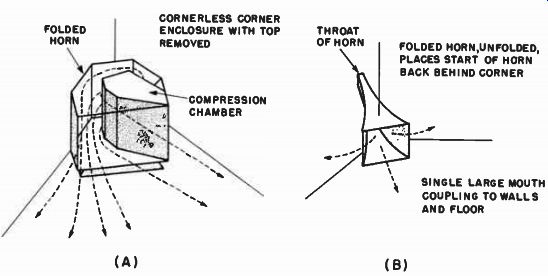
Fig. 16-3. A folded horn when placed in a corner actually puts the start
of the horn behind the corner, which effectively elongates the corner
of the room into a better horn. FOLDED HORN , CORNERLESS CORNER ENCLOSURE
WITH TOP REMOVED COMPRESSION CHAMBER THROAT OF HORN FOLDED HORN,UNFOLDED,
PLACES START OF HORN BACK BEHIND CORNER (B) SINGLE LARGE MOUTH COUPLING
TO WALLS AND FLOOR
Horn Enclosures are Extended by Room Corner
The box type enclosure will, of course, benefit considerably as out lined above. The horn enclosure will benefit much more in proportion. Since these horns are all of the folded variety (in order to obtain the proper length of horn in a reasonable living room size), the actual acoustic column length within the horn may be somewhere between five and seven feet. If we could now unfold the horn, leaving the mouth area where it is in the corner of the room and extend the straightened horn towards the back, the horn would obviously extend into the area behind the corner. In other words, if we want to consider the source of sound in the horn, we find its virtual location removed several feet behind the corner with the horn protruding into the corner as shown in Fig. 16-3. By this expedient we have not only elongated the horn effect of the room corner but we have obtained even better coupling into the room corner. The overall effect of a horn enclosure in a corner of the room is to get high efficiency, low frequency sound well projected into the room.
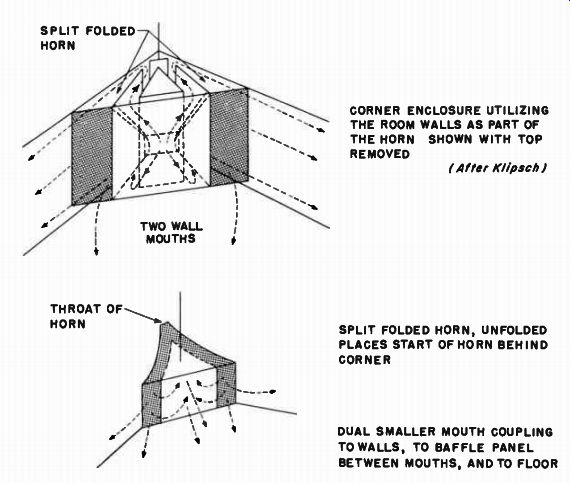
Fig. 16-4. The split folded horn couples into the corner of the room
through two mouths, with the horn sections effectively removed behind
the corner. CORNER ENCLOSURE UTILIZING THE ROOM WALLS AS PART OF THE
HORN SHOWN WITH TOP REMOVED After Klipsch SPLIT FOLDED HORN, UNFOLDED
PLACES START OF HORN BEHIND CORNER DUAL SMALLER MOUTH COUPLING TO WALLS, TO
BAFFLE PANEL BETWEEN MOUTHS, AND TO FLOOR
Inspection of the horn intended solely for corner use (Figs. 8-5 and 8-6) will show that its final configuration is not quite as simple as shown in Fig. 16-3(B). It will be observed that this corner de pendent type of horn actually has two mouths on the sides separated by a panel board between them, which actually is the housing for part of the horn. Hence, the horn is split into two symmetrical horns starting from a single throat, folded side by side and coming out of separate mouths. Accordingly, if we were to represent this structure in its unfolded state as it couples into the room, we would have the structure shown in Fig. 16-4, in which are shown two horns of comparatively smaller mouth dimensions coupling into the side walls with a common baffle between.
Comparing these two structures, we see that there is a difference in the manner in which the self-contained horn, Fig. 16-3, and the corner integral horn, Fig. 16-4, couple into the room. In the self contained horn with its large one-piece mouth, the horn is coupled to the two walls and the floor with the sound from the mouth distributing itself rather evenly between the three planes because the mouth is symmetrically placed with respect to them. In the case of the integral corner horn, the sound is more closely coupled to the walls of the corner rather than the floor, with additional coupling from the two mouths to the flat panel between them, which then in turn couples into the corner. In the former, there is direct horn coupling to the corner; in the latter there is combined horn coupling to the walls and "baffle" coupling into the corner. In both cases, however, once the coupling has been established, the corner radiation takes effect and the horn is well coupled to the room.
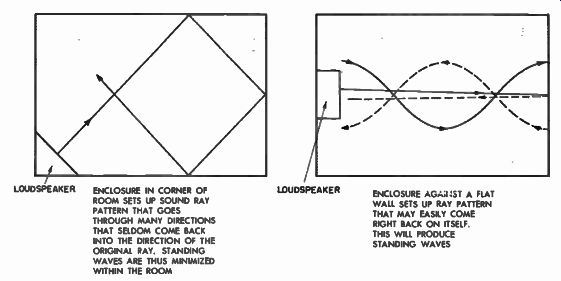
Fig. 16-5. Placing the enclosure in the corner of the room will minimize
standing wave pattern and will thus produce more even distribution
of low frequencies throughout the room with absence of hot spots or null
points, in addition, of course, to better low frequency response in
general. --------- LOUDSPEAKER ENCLOSURE IN CORNER OF ROOM SETS UP SOUND
RAY PATTERN THAT GOES THROUGH MANY DIRECTIONS THAT SELDOM COME BACK INTO
THE DIRECTION OF THE ORIGINAL RAY. STANDING WAVES ARE THUS Minimized WITHIN
THE ROOM LOUDSPEAKER ENCLOSURE AGAINST A FLAT WALL SETS UP RAY PATTERN
THAT MAY EASILY COME RIGHT BACK ON ITSELF. THIS WILL PRODUCE STANDING
WAVES
Corner Placement Minimizes Room Standing Waves
Placing the enclosure in the corner of the room has another beneficial effect upon low frequency reproduction. Corner placement minimizes standing wave effects within the room. Figure 16-5 compares the two paths that may be taken for a particular low frequency sound ray from a corner placement and a center wall placement. The corner placement sends off the rays at an oblique angle to all the wall surfaces, hence the sound must bounce around from wall to wall many times.
In this case, the sound energy would seldom find itself travelling back ...

Fig. 16-6. Corner placement of enclosure not only helps lows, but also
insures that the listener is always in a very favorable position for
the reception of the high frequencies. THIS LISTENER MAY BE AS MUCH
AS 90 degrees. OFF THE AXIS OF THE SPEAKER THIS LISTENER IS ALWAYS WITHIN
45 degrees OF THE AXIS OF THE SPEAKER IN THE CORNER.
... toward the loudspeaker along the same line as the original radiated sound. As it is essential for the setting up of standing waves to have the incident sound energy and the reflected sound energy travelling in opposite directions but along the same line of travel, standing waves are not ordinarily set up when corner placement is used. In the case of the flat wall setup, however, the reflection from the wall falls back upon the incident or transmitted energy and standing waves are readily set up.
Corner Placement Improves High Frequency Coverage
Although not specifically affecting the high frequency dispersion from the loudspeaker, placing the enclosure in the corner of the room may provide better high frequency coverage over the room as a whole.
There are, of course, high frequency reproducers designed to give wide angle coverage through the design of the radiating horn. The various types of tweeter horns, such as the reciprocating flare type and the diffraction type, do generate considerable high frequency sound energy at a wide angle from their horn axis. However, despite the spread that may be obtained from the horns designed for this application, there is still much to be gained for the listener if he is placed closer to the axis of the horn. Figure 16-6 illustrates the fact that when the speaker is in the corner of the room, the listener cannot possibly be more than 45 degrees off the axis of the horn, because the corner of the room subtends at the most an angle of 90 degrees. On the other hand, in the case of the wall placement, the listener may find himself as much as 90 degrees off of the axis of the high frequency horn. Consequently, from the corner placement, more uniform high frequency coverage will be obtained throughout the room.
Thus, for high efficiency low frequency reproduction and for more uniform high frequency coverage, it is of specific advantage to place the enclosure in the corner of the room. Whether it is a simple bass reflex enclosure or a horn-loaded type, it will work better in the corner of the room.
There Should be No Obstacle Between Ear and Sound
Since the ear is just as much an element in the acoustic circuit as the loudspeaker and its enclosure, we must consider the problem of placing the ear in the correct position in the room as well as placing the enclosure in the right position. It should not be inferred that there is only one best place for the listener to sit to enjoy his system. What is important is to realize that there is a certain relationship that should obtain between the loudspeaker, the room, and the ear if all the benefits of a hi-fi system are to be enjoyed.
Obviously, we desire the same effect in the listening room as in the concert hall. It would be completely distracting to a listener in an auditorium if he were to be placed behind a post. Of course, his vision would be hindered, but he would suffer auditory discrimination as well.
Essential parts of the musical spectrum would be blocked from his ear and he would not get the full benefit of the music. However, such a situation seldom arises in the concert hall. Such rooms are designed to give a completely unobstructed line of hearing from the stage to the listener, no matter where he sits. This then should be one of the prime objectives in arranging one's high-fidelity music room. As obvious as this precept seems, it is too often violated, unintentionally, of course, to the detriment of the system as a whole.
Now there is a distinction between making sure that there is an unobstructed path of sound between the loudspeaker and the ear, and the principle of point sources of sound. The two are by no means the same. Point sources of sound are to be avoided if realistic concert hall reproduction is desired. By no stretch of the imagination does a point source of sound exist in the concert hall. In the case of the full orchestra, naturally, the sound comes to our ears from a very wide acoustic aspect. Even in the case of a soloist with a small instrument, or a singer, despite the fact that the sound they produce comes virtually from a point source, our ears hear that original sound plus all the reverberant sound of the hall. So we hear not a point source of sound, but a diffuse source of sound added to the point source, tending to give an illusion of breadth. Point sources of sound are to be avoided for the sake of acoustic realism. However, direct line of "sight" to all the sources that provide the music should be maintained.
If the source is a simple enclosure, there should not be any "pillars or posts" between the listener and the enclosure. An obstruction will simply cause a reduction of the high frequencies because they will not diffract around the obstacle as easily as will the low frequencies.
Consequently, the program material will be unbalanced.
There Should be No Absorption Surfaces Close to the Ear
The closer the obstruction to the listener, the worse will be the masking effect upon the high frequencies. As an example that is not too far from typical, consider the listener to be seated in a wing back chair with his head comfortably resting in the corner of the wing. Several things may now happen. Even if his chair is placed so that it faces directly out into the room, the wing section may completely block the sound from coming to one of his ears, and the overall effect will be one of muffled highs. Moreover, if the chair is of the deeply overstuffed variety, the listener's ears will be closely surrounded by highly absorbent material, which will have the same deadening effect as the obstructing wing itself. Perhaps this raises the general question of hi-fi "furniture." Well, to be truthful about the matter, the acoustic properties of furniture have been of considerable concern to the designers of the music halls and concert rooms. They figure quite prominently in the acoustic equations that determine how well the room is going to function. Tables of absorption coefficients for many types of upholstery are available, showing the relative absorption of the fittings, and such factors are closely integrated into the calculation of the reverberation time of the room itself. This matter will be illustrated in the next section, where it will be shown how the room may be adjusted acoustically to provide the proper liveness for good all around musical reproduction.
Getting back to the listener's chair, even if it is a hard back slender occasional chair, we may still run into difficulty if the chair is placed against a heavily draped wall. The highly absorbent draped area will cause deadening of the program brilliance because of the elimination of the apparent "wall source sound" near the head. With the absence of the reflective surface close to the ear, all the ear hears is the original sound from the speaker, without benefit of any room diffusion. This results in pinpointing the sound back at the speaker area, a condition we try to avoid. Consequently, despite the overall liveness of the room, if the listener's ears are close to heavily absorbent material, the program will be deadened.
Perhaps the simplest example with which to illustrate the importance of the listener position in relation to the enclosure is to suggest that the reader leave the room in which his system is playing and go into some adjacent room. Immediately, he will sense the loss in brilliance and in the "presence" of the music because he is out of direct line of hearing from the system as a whole. It is thus seen that the combined effect of the listener's position and the loudspeaker-enclosure position in the listening room is one that may very greatly affect the overall performance of the system.
Enclosures and Their Placement for Binaural Listening
Before we leave this specific subject and go on to the matter of adjusting the room to match the system, it is necessary to spend a few moments on enclosure placement in connection with "binaural" or "stereophonic" program material and sources. The question of binaural or stereophonic reproduction is befitting a study all by itself, and is beyond the scope of this book. However, despite the pros and cons of the argument, there is no question that such reproduction is considerably different from the more simple conventional program sources.
Despite the fact that there is no unanimity of opinion as to the best form of such binaural reproduction, or whether it is really "n"-dimensional, the fact remains that added acoustic perspective and spread is produced by these systems, resulting in increased realism of reproduction. There are today several "binaural" broadcast programs which may be enjoyed by individuals who have separate a-m and f-m receivers; also there are binaural discs and tapes for those who have the reproducing equipment to handle them.
The placement of the loudspeaker enclosures for binaural re production is somewhat more critical than for conventional monaural reproduction, and the placement of the listener is also of greater importance. If the enclosures are of similar kind (as they should be for optimum performance) they should be placed in parts of the room that are acoustically similar. Thus, if two corner systems are used, they should be placed in two similar corners. If the enclosures are of the non-corner type, they should be placed along a wall that is symmetrically decorated. The objective of this precaution is, of course, to ensure that the acoustic properties of the walls are the same for both enclosure systems so that they will have the same acoustic compensation. For instance, it would be undesirable to have one-half of the wall heavily draped, and the other bare, with the enclosures located in front of these vastly different acoustical fronts, which would change the acoustic performance of the systems.
The enclosures should not be too close together, for their reproduction would then merge into a point source, and the binaural effect would be lost. On the other hand, the enclosures should not be placed too far apart; the various musical sources would then become too "disembodied" from one another and there would be a loss of integration of the musical group. The room should not be too live or the resultant excess diffusion would defeat the stereophonic positioning of the sound sources. The listener should be seated equidistant from both systems.
This insures that he will get the optimum balance of sound between the two systems without electrically overdriving one system over and above the other. This is to say that both systems should be played at equal loudness, and that for equal reception from both sources, the listener should place himself roughly equidistant between the two.